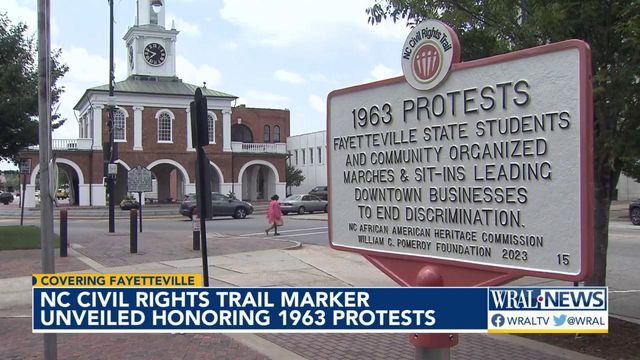'Turned Fayetteville upside-down:' Students desegregated a city in summer of 1963
On Friday, a new historic marker will be unveiled for the NC Civil Rights Trail -- cementing Fayetteville's addition to the trail of history that stretches across the state, highlighting key moments in civil rights history.
A full year before the Civil Rights Act of 1964, students from Fayetteville State University, a historically Black university, began peaceful protests that resulted in the necessary political pressure to influence elected leadership to direct businesses to desegregate Fayetteville. Their demonstrations in the summer of 1963 were part of the push that lead to the major changes that came the next year. It also was the catalyst for the first mayoral committee focusing on race relations.
That summer, Fayetteville became a focal point for the protest of racial segregation. Protesters, who took routes down Hay Street, Person Street and Green Street, took significant risk by joining in sit-ins and demonstrations. Many protesters were afraid of losing their jobs. Many were arrested. Many were hit by water hoses and smoke bombs as they demonstrated. But despite the push back, the marches began a series of protests and sit-ins that sparked like a chain-reaction of courage.
'I turned Fayetteville upside down:' Students succeed in desegregating much of Fayetteville
Their courage and success has since served as an inspiration to future generations of students and proof that young people can make a difference.
"I lead the downtown marches and turned Fayetteville upside down," said Dr. Willis McLeod, former FSU chancellor and class of 1964, who thanked God he'd lived long enough to see the changes he fought to enact.
"Hundreds of students from FSU, and at times E.E. Smith Senior High School, sacrificed their dignify to help bring down the walls of segregation," he recalled.
He said their work helped foster a better understanding and helped change how other people perceived the Black community – seeing them as God's children, just like everyone else.
He said the sit-in movement began in Greensboro at North Carolina A&T. It was 1960, just a few years earlier, when the famous story happened: Four Black college students sat at an all-white lunch counter at Woolworth's in Greensboro. The sit-in prompted similar peaceful protests in at least 250 municipalities across the country by the end of that month -- and the movement kept rolling.
"We were getting mad," said McLeod.
He said he marched until he feet ached.
"The firemen used their water hose, the police used smoke bombs, but we were determined and continued to march, singing, 'We shall overcome,'" he said.
Ripple effect: Sweeping changes in desegregation from May to July
On May 18, 1963 over 200 FSU students joined in a peaceful protest.
"These students did not stand alone. The community rallied together with pastors, physicians, attorneys, teachers and many others. Some sit among us today," said DJ Haire, a Fayetteville city councilor. "Then Fort Bragg, now Fort Liberty, gathered together and supported those demonstrations in June."
By July, even more changes were happening: The local NAACP agreed to a 5 point plan that was presented to the mayor's bi-racial committee, which introduced efforts to increase employment for Black individuals in stores. They also pushed for an end to segregation practices in local businesses.
"The impact of these collective efforts came to bare fruit in 1963, when segregated businesses right here in our hometown became the exception rather than the norm," said Haire.
All four downtown theaters, as well as most restaurants and hotels, had been desegregated.

Following the NC Civil Rights Trail
"Most every community in North Carolina has its own Civil Rights history. It's in our big cities, but also in smaller towns and rural spaces, where everyday citizens came together to make a change in their community," said Adrienne Nirde, associate director of the NC African American Heritage Commission. "There's a real interest and need to physically mark this history."
City councilor Shakeyla Ingram said that being inducted to the NC Civil Rights Trail puts Fayetteville permanently in the story of change.
"I am only standing here today because of the courage and resilience of those demonstrators," she said.
The marker unveiling was held near the southwest corner of the Fascinate-U Children's Museum, which was the location of City Hall in 1963.
The N.C. African American Heritage Commission leads the N.C. Civil Rights Trail with funding from the William G. Pomeroy Foundation, and with support from Visit North Carolina and the North Carolina Office of Archives & History. The commission works with communities across the state to designate up to 50 sites where trail markers are being placed, including 10 in Hometown Strong communities. An interactive web portal highlights these places and others to guide people to history and experiences from the past.













